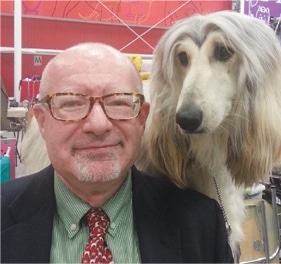
Home » Liz Hansen – Sketchbook Standard Schnauzers & Berger Picards
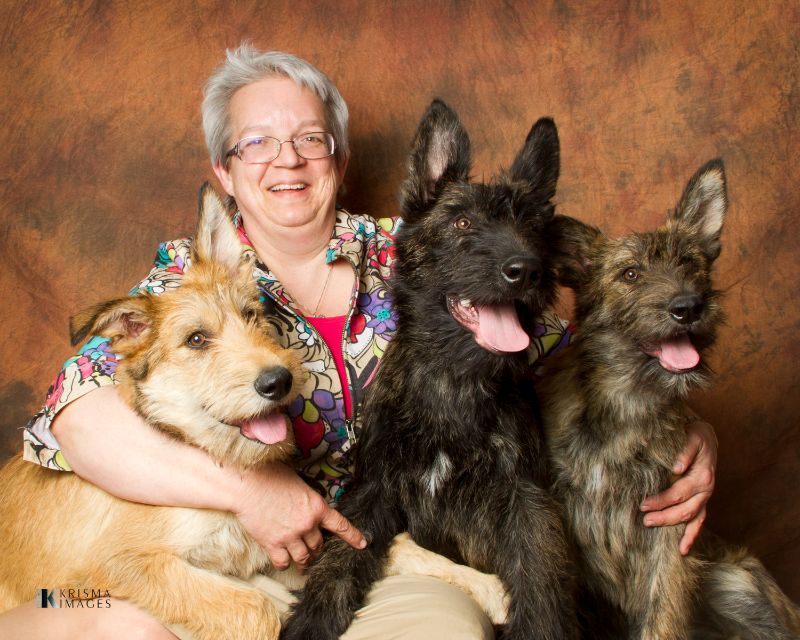
Liz Hansen: I was born in Minneapolis, Minnesota. When I was five, my parents bought a great house on several acres in Eden Prairie that came with a bunch of chickens and ducks, a big orange tomcat, three sheep, and a pony. My siblings and I grew up having many adventures with horses and ponies, and my sister and I did some local horse shows and trail rides.
Liz Hansen: Our family had other animals, but not dogs. My sister and I did horses together, and bred and raised a few foals. After several “Can we please keep it?” strays that were denied, in high school one of my teachers had a relative who needed to place a young English Springer Spaniel. My parents said okay on condition that I take it to obedience school and train it. A lucky coincidence! Francie Nelson (Chuzzlewit ESS) at that time lived next door to my grandmother, and Francie became a great friend and mentor.
At Bloomington Obedience Training Club, we met Sharon Hodgens-Wood and her incredible Standard Schnauzer, “Frieda” (CH & OTCH Hodgendell’s Frieda Houdini). When Frieda had her only litter, Sharon trusted two teenagers with a fantastic puppy who became CH Frau Gretel von Friedalin CDX, and the foundation of Sketchbook.
Liz Hansen: Francie Nelson was a fantastic mentor, and through her, I was introduced to Mary Lee Hendee (Canarch ESS). When we were headed to the ESS National with my first ESS show puppy, Francie told me words that I remember to this day, and share with others—you go to a National to learn, to see and meet the dogs and people you’ve heard about or seen in magazines and pedigrees, and to gather all the information you can. If you come home with a ribbon, that’s a bonus, but observing and learning is why you go to a national. If you approach specialties this way, you always come home a winner.
It took a few years with both ESS and SS, but after a while it became obvious that the Standards were a better fit for me than Springers, but Francie, and many other ESS people, remain friends to this day.
Sharon Hodgens-Wood has been a great mentor and teacher, and got us started on the right path with Standard Schnauzers. We still have a friendship that I value dearly. Early on, we also met Penny Duffee (Morgenwald SS), and Penny and I have a long friendship, and innumerable discussions about the breed.
When I first saw Berger Picards, I met Betsy Richards (AllStar BP) not long after the BPCA was formed. I had 30-plus years of dog experience by this time, but Betsy was a dynamo for connecting Picard people and promoting the breed. I’m sorry she’s gone, and I miss the discussions we used to have about the breed and many dogs.
I’ve now also been on the other side of this, and mentored several newer breeders, which is a fantastic learning experience as well. Putting into words the things that are important, and why you believe they’re important, can make you rethink and examine what you’ve done that might have become “routine,” and focus on key points in the breed.
Liz Hansen: It always has to be the total dog for me. The original purpose of the breed is a constant reference point, because they would not exist if those early breeders had not created a dog well-suited to do a certain job. Both Standard Schnauzers and Berger Picards were functional, multi-purpose farm dogs, doing the jobs that needed to be done, moving all day, thinking on their feet, assessing new situations and making appropriate responses to whatever presented itself.
Working dogs and Herding dogs are rarely working if they’re standing still—their job requires them to move, so they must be able to move efficiently and effortlessly, without getting tired. All the features that make up breed type are to assist with their function, with doing their job. That they are healthy and sound almost goes without saying—they can’t do their job if they’re not physically and mentally sound.
With the Standards, most of my breedings are loose line-breedings. With our foundation, I bred to three unrelated stud dogs, and working from that beginning, I have been able to work back and forth to different avenues within my line, and pick up things I want to improve or solidify by selected crosses to other lines that are producing what I need.
With the Picards, it feels like we are still learning a lot of what’s behind the dogs that were imported to establish the breed here in the US, so I have not done a lot of line-breeding yet.
Both of these breeds have small numbers and restricted gene pools, so a consideration for genetic diversity is part of the equation, and I am not comfortable doing tight line-breeding or inbreeding.
Influenced by my mentors and other very successful breeders, I always have a plan for at least two or three generations beyond just what the current breeding will be. The plan can be revised based on what I do or don’t get in the litter, but there is a plan to get what I need and keep the good that I have.
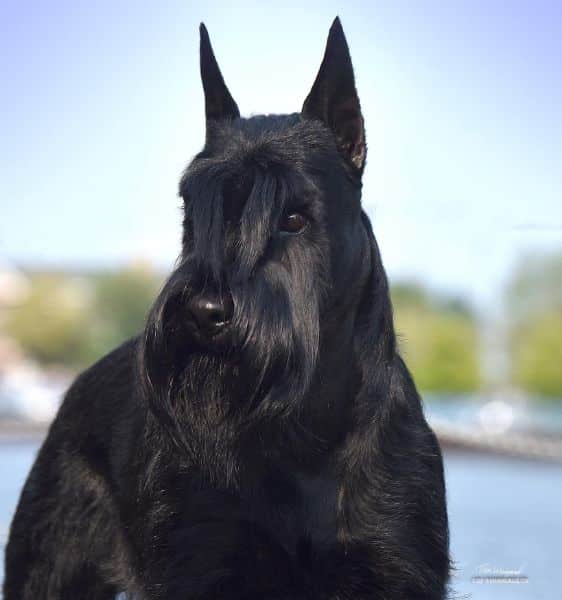
Liz Hansen: For most of my history with dogs I’ve had four or five, but then, about the same time I added the Picards, I also started breeding black SS in addition to the pepper-salt, so now I’m basically maintaining three breeding programs. I try to place many of the dogs that I want to include in future breedings with good people that I can trust to work with me and give me access to continue the line.
This gives the dogs more one-on-one time and activities, and spreads the joy around for others to have fun with them as well. I’m fortunate to have 10 acres, a couple large fenced yards and smaller runs, and a large dog room in the house. Who gets to be bedroom dogs changes, other than a couple regulars. I spend a lot of time outside, and generally have several “supervisors” out and about with me while I’m working on projects. They get to be dogs first, and on some weekends they get dressed up for the dog show!
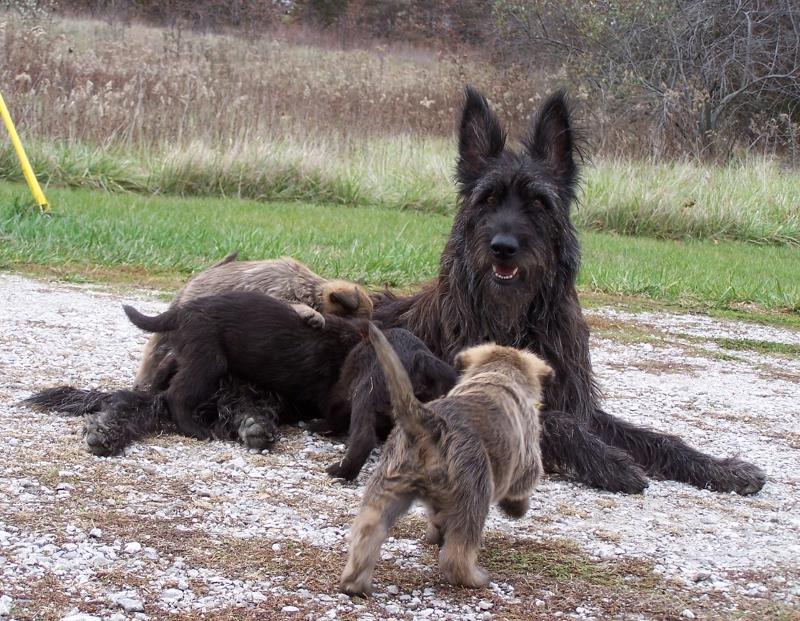
Liz Hansen: The Sketchbook dogs have nearly all been owner- and/or breeder-handled, so the nearly 200 champions and similar number of performance titles make me very pleased and proud. Many of the dogs have titles at both ends of their names, and the ability to succeed in both conformation and performance events is very important to me.
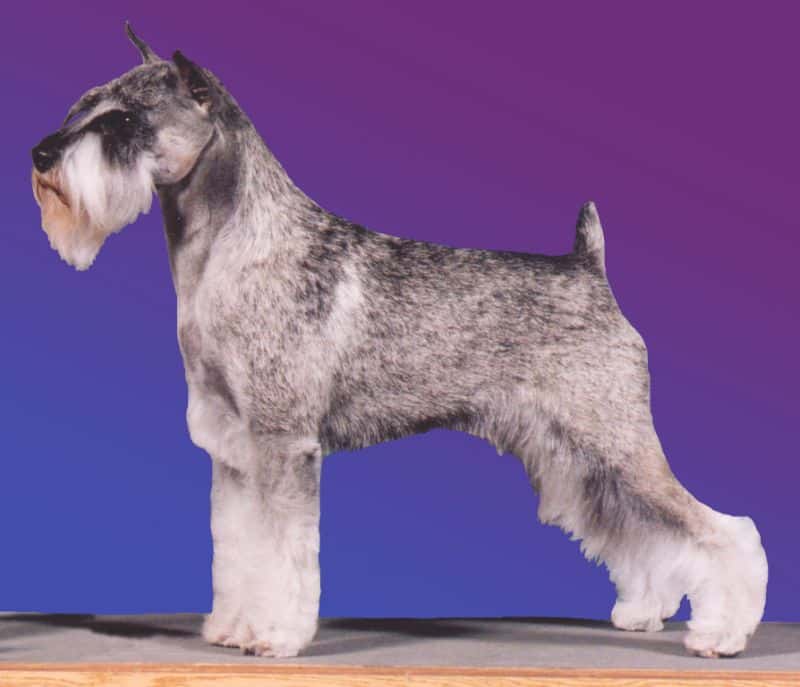
CH Scarlight’s Seasar TD NA, “Seasar,” has been my biggest winner thus far. His mother was bred here, exported to Sweden, and Seasar came to me as a little puppy. Owner-handled throughout his entire career, he was No. 1 SS in the nation 2003, 2004, and 2005, National Specialty winner 2004, Best of Breed at Westminster four years in a row 2003-2006, three all-breed BIS (all shows over 1,100 dogs), No. 17 Working Dog in 2005, and the first SS to go BIS with performance titles already earned.
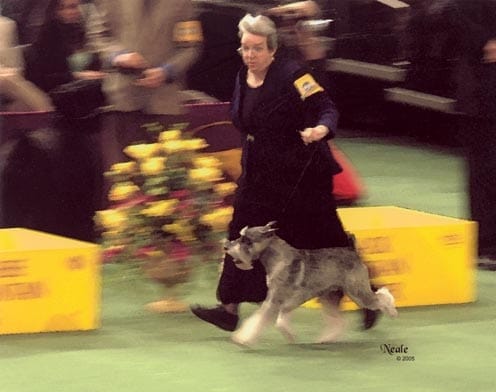
He is a SSCA Hall of Fame producer, and his son, “Vegas,” Am/Can CH GCHS Sketchbook Neon Lights HSAs, is the youngest BIS winner in the breed.
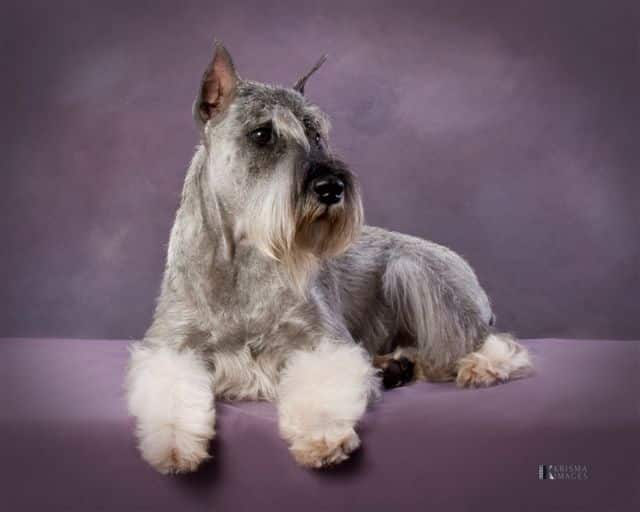
In Picards, GCHP Sketchbook I’ve Got Ewe Babe CM, “Sonny,” was shown both by Eileen Hackett (who owns his sire) and by me. He is currently the only Platinum GCH in the breed, won the National Specialty, first male all-breed BIS, several RBIS, and multiple NOHS BIS wins.
[wonderplugin_3dcarousel id=65]
In the NOHS Lifetime Points ranking, Sonny is No. 1 Picard and three other Sketchbook dogs are in the Top 10. Standard Schnauzer No. 1 is GCHS Sketchbook Rodeo Clown, “Rooster,” with three others in the Top 10.
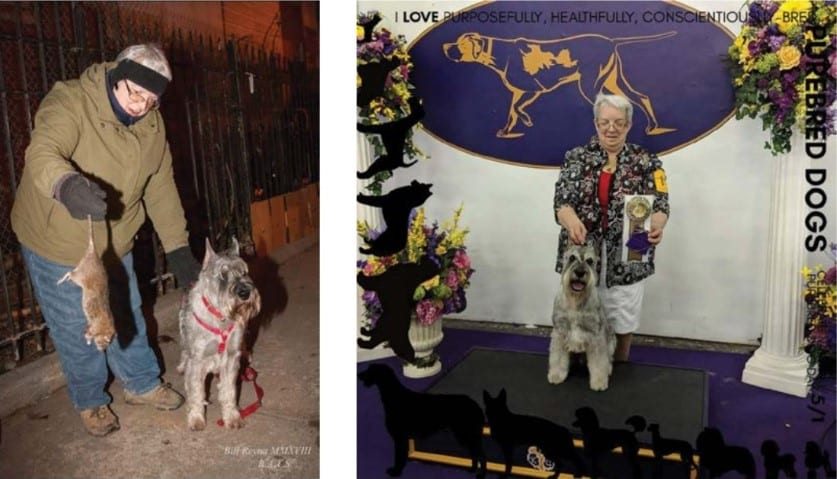
The first Herding High in Trial, and first HTCH in both Standards and Picards are dogs I bred, and they are both also champions. In Picards, this is DC Sketchbook Go For The Gusto CM HSAds HIAds HXAds, “Gus,” and in Standards, this is GCH DC Sketchbook Stack The Deck RA HSAs HIAs HXAsM, “Zack.”
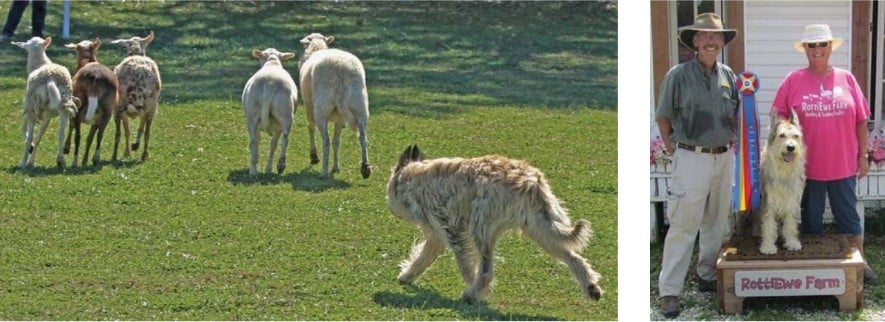
Over the years, we’ve been fortunate to have numerous SSCA Leading Producers and Hall of Fame Producers, and win the Stud Dog or Brood Bitch of the Year award. The BPCA has not set up a recognition system for Picards yet, but the dogs that have been used have produced well.
There have also been several successful Junior Handlers showing Sketchbook dogs, and we’re very proud of each of them as well.
We also have several who have been service dogs for their owners. Perhaps most significant of these is “Tux,” Sketchbook Top Hat and Tails TKN. He was returned to me at age eight years due to his owner’s failing health, and was placed in a new home. The new owner has severe celiac disease, and after Tux had been there a few months, we discussed gluten detection dogs. Against the advice of service dog trainers who thought he was too old, the new owner trained him to detect gluten, and Tux has become an invaluable service dog and fantastic ambassador for the breed, demonstrating impeccable manners wherever he goes, and an intuitive sense for helping people.
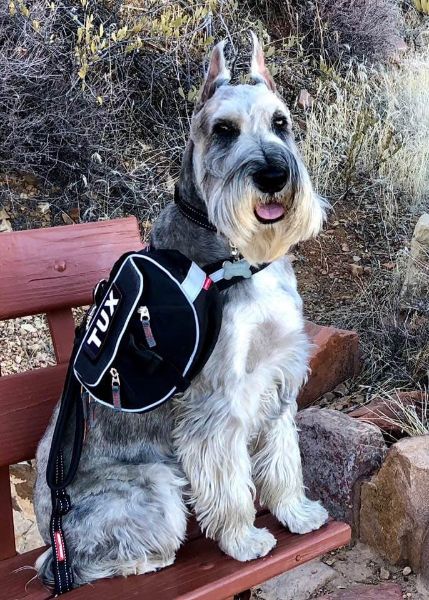
Liz Hansen: Until fairly recently, most Standards were being shown by their owners or breeders. With more being presented by professional handlers, the grooming and training overall is better, or more consistent. Frankly, it’s a little disappointing that more owners aren’t putting in the effort to learn to do this themselves, because there’s a great deal of learning accomplished by working the coat, hands on the dog critically, over and over. I am not the only longtime breeder who feels that the overall quality is not what it was 10 or 20 years ago.
When I do Judges Education, or mentor, I tell people to remember that this is a working dog that just happens to have a hard coat, not a big terrier that does more than kill vermin. We have a lot of short upper arms (as do so many breeds) and upright fronts, sometimes paired with too much angulation behind, which does not make the correct, smooth, effortless gait with no wasted motion. Too much “fancy and flashy” is rewarded (and then desired by some), and this is not a breed that should be fancy or flashy. The dog which looks like he’s out for a leisurely trot is probably more correctly structured, and would be able to keep that up all day.
The dog which looks like he’s out for a leisurely trot is probably more correctly structured, and would be able to keep that up all day.
The Picards are pretty new in AKC shows, and when they first were recognized, many judges commented that for a “new” breed, they were pretty consistent in type. We can thank the French for that, and need to be vigilant that we don’t drift towards fancy and flashy here, too. Most owners and handlers are doing a better job of socializing and training their dogs, and there’s a bit less of the dogs that have a meltdown over being examined, although it’s a work in progress for young dogs especially. Most of the dogs move pretty well.
We need to make sure to keep the long upper arm, well-angled front and rear, and prominent forechest. While their coats are not as hard as the Standard Schnauzer coat, it is supposed to be a crisp, hard coat, and not long. Correct coat texture cannot be evaluated if the dog was bathed and blow-dried just before going in the ring. They should not be dirty, but they should not have long, flowing hair—there needs to be texture to it.
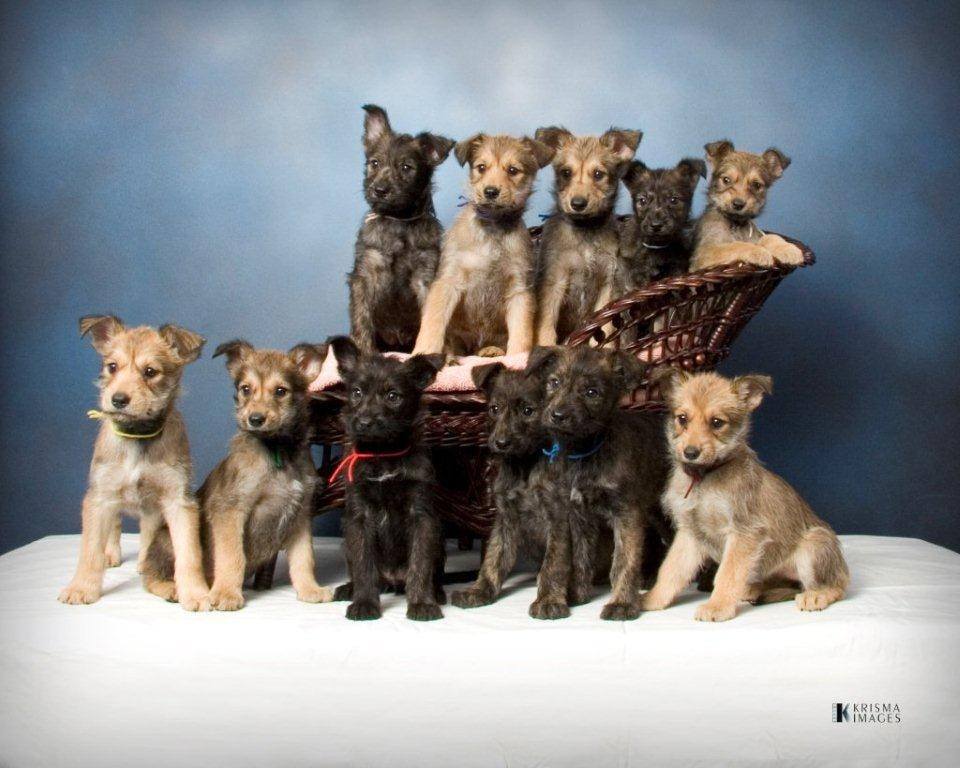
With both breeds, there’s a lot of good there, but breeders, owners, handlers, and judges need to resist the urge to reward fancy and flashy—both breeds should be sound, capable farm dogs, without exaggeration. There is a core group of very dedicated fanciers for both breeds, doing their best to remain true to the dogs, and continue to bring good dogs into the world.
Liz Hansen: It’s tough in today’s instant gratification world—the people willing to dedicate time and patience to something are rare. As breeders, we need to teach and encourage new people at every opportunity. Some people at shows are not very welcoming, but most can be if they’ll just remember that they were an excited beginner once, too! I also try to remind new people that learning all this is a long process—nobody is born knowing it, and with work and practice, they CAN find a way to succeed with a good dog.
That said, it is increasingly more difficult to compete with professional handlers when you’re an owner-handler who needs to work a “regular” job (as in, not a pro handler) to pay for the privilege of showing your dog. It’s not possible to attend multi-day clusters week after week after week, so accumulating the numbers needed to achieve top ranking in today’s system just isn’t possible. It’s important for judges to remember to judge the dog in their ring on a given day, not a show record, not an ad campaign, not the other end of the lead.
Choices matter. Each exhibitor paid the same entry fee, so they all deserve to at least feel like they got a fair look. From the exhibitor side, though, we need to be sure we’re doing our homework, training ourselves and our dogs, and taking the time to learn how to present them at their best. Each day is an opportunity to learn. And, you always take the best dog home with you, win or lose!
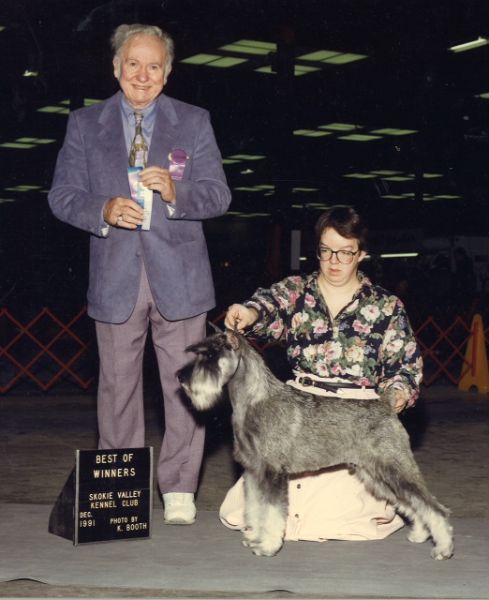
Liz Hansen: I’m more than 45 years into this now, but not ready to stop for a while yet, hopefully! There are young dogs coming along that I am excited about, and frozen semen from some very nice dogs that I’d like to go back to and bring some of those qualities forward. I will continue to mentor where it’s wanted, and coach more juniors and new fanciers. I hope that some of what I’ve worked to produce over the years will be carried on with other breeders once I’m too old to do it anymore—but I’m hoping that’s not any time soon!
Liz Hansen: My kennel name of “Sketchbook” came from a lifelong urge to draw things. I’ve always been interested in art, and in science, and turned that into a degree in Scientific Illustration. I spent 13 years as the illustrator and photographer for the Center for American Archeology. Most of the drawings I produced were for excavation reports, some museum exhibits, a large study of Middle Woodland pottery, and a drawing of a 5,000-year-old stone tool was part of the “Art in the Service of Science” exhibit at the Smithsonian.
Almost 24 years ago I had the opportunity to join the research team at Dr. Gary Johnson’s lab at the University of Missouri College of Veterinary Medicine, where we search for the mutations causing heritable diseases in dogs. I have not done much drawing lately, but am very pleased to be where I know we’re making a positive impact for the health of dogs, and happiness of their owners. My training as a scientific illustrator helps me to communicate difficult scientific concepts in a way that is more easily understood by non-scientists, and my involvement in dogs lets me bring the concerns of dog people to the researcher team, so it’s a great place to be.
We’ve discovered mutations responsible for about 50 different canine diseases so far, and wise use of DNA testing for these mutations is helping to reduce the incidence of heartbreaking diseases in many different breeds. It’s a privilege to do dogs for work, and dogs for fun!
Featured photo: Liz with 5-month-old siblings, ‘Greg,’ GCH Sketchbook Gold Medalist CM PT (fawn), ‘Gilli,’ UKC CH Sketchbook Gilligan (dark brindle), and ‘Charm,’ CH Sketchbook Good Luck Charm CM PT
